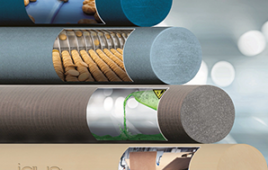A recent symposium on Liquid Silicone Injection Molding (LIMS) focused on products for medical and multi-component molding, anti-microbial additives for liquid silicone, and silicone dispersions.

Silicone is chemically inert. It won’t react with blood or pharmaceuticals and can be put in a dishwasher. It is naturally translucent but can be colored, and its low surface energy suits products like bake-ware and kitchen utensils.
The Shin-Etsu Silicones of America, Inc., presentation on LIMS for Medical/Multi-Component Parts covered several of the innate physical properties of silicone that make it ideal for modern medical product applications. These properties include: broad thermal stability (-65 to 400 ° F; but with additives it is thermally stable to 500° F), electrically and thermally non-conductive, naturally elastomeric, and a hardness range of 5-80 Shore-A that allows manufactures to tailor the feel of the material.
One medical application involves respiratory masks for sleep apnea conditions. The silicone adds comfort and seals well against the face. Long shelf-life stability and high tear strength make it suitable for other products like baby bottle nipples and earplugs.
Silicone is chemically inert, so it won’t react with blood or pharmaceuticals and can be put in a dishwasher. It is also naturally translucent but can be colored for quick identification for medical operating room applications. And it has slippery properties, so it suits products like bake-ware and kitchen utensils.
The KE2004 series has a low-end durometer: 5-20 Shore-A. The low-hardness and high tear strength combination can give products a soft feel without sacrificing strength, generating excessive flash, or tearing during demold. All products in the healthcare series meet medical device biocompatibility standards including: ISO 10993, USP Class VI, and CFR 177.2600
The low-volatile KEG2003 series meets the European EN 14350 requirement for child use-and-care articles. These silicone materials can be used in liquid injection molding systems in a closed-loop, automated process that minimizes the risk of contamination.

At a recent symposium on silicone, several manufacturers introduced additives that enhance the properties available with this material, especially for medical applications.
Milliken & Company, a textile and chemical manufacturer, introduced a new antimicrobial additive, named AlphaSan® CW 12, for use in LSR silicone elastomers. The completely inorganic additive contains silver ions as its active antimicrobial ingredient and features high thermal stability, low moisture content, and a small particle size.
Silver ions are effective at inhibiting the growth of a range of microbes, including bacteria. When bacteria are exposed to silver ions they can no longer generate sufficient energy to reproduce, thus inhibiting their growth. This concept is the basic mechanism behind AlphaSan® CW 12, a soluble powder additive dispersed in LSR silicone.
It is biocompatible and has negligible impact on material function. It is available in powder and concentrate versions that can be added as a third stream LSR additive. When using a medical grade LIMS™ silicone, up to 10% of CW 12 can be dispersed into the silicone without affecting material properties needed for medical applications.
Arburg, a leading global manufacturer of injection molding machines for plastics processing with clamping forces between 125 kN and 5,000 kN, covered how LSR can be used as one or both materials in a 2 C-Equipment system for multi-component silicone applications-shower head seals, push-button seals, electronic housings/insulator parts, consumer soap dispensers (silicone seals after pump squeeze) and intricate medical applications.
Fluid Automation discussed the main objectives of Meter-Mixing Dispensing, which are to provide a consistent ratio of material to the injection-molding machine feed throat at a repeatable pressure. Silicone molds differently than plastics, therefore the geometry of the mold and its application are crucial. Typical injection molding machines use 5-55 meter-mixing models capable of using 5-or-55 gallon containers of LSR and third and fourth stream additives for both medical and industrial models. Medical application models integrate all wetted components with Stainless Steel and special Teflon-lined hoses. For third and fourth Stream Additives such as antimicrobials, color injection controls make it easier to change the percentage of additives into the material; as low as 2/10th of a percent up to 8 and up to 15% for antimicrobials.
Shin-Etsu Silicones of America, Inc. and Arburg Inc.
www.shinetsusilicones.com
::Design World::
Filed Under: Medical-device manufacture, Materials • advanced





Tell Us What You Think!